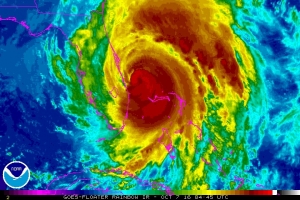
In early October, Florida Gov. Rick Scott rushed to prepare citizens for Hurricane Matthew as it swept Haiti, Cuba and the East Coast of the U.S. with 140 mph winds. Because it was registering as a Category 4 storm at its strongest points, the governor activated 3,500 members of the National Guard to help citizens. That was the right decision, but a very costly one.
Other public officials are being called on all too often to make similar decisions in emergency situations. Natural disasters are occurring at increasing rates. Most believe that climate change is the culprit but, for whatever reason, the cost to government is extremely large. The New York Times reported recently that natural disasters alone could result in costs of $300 billion by 2030.
Interoperable communications – a high-cost necessity when emergencies occur – is very expensive. In spite of the fact that communication often is the difference between life and death, not all regions have been able to implement robust communication systems.
 Interoperable systems allow all first responders to communicate with each other because they are all on the same frequency. Public officials and emergency workers understand the value and truly want interoperable communication, but funding is a huge obstacle. Even with some assistance currently available from the federal government, it is far from enough to cover the cost. That will change in the future, but at the moment, it is only a promise.
Interoperable systems allow all first responders to communicate with each other because they are all on the same frequency. Public officials and emergency workers understand the value and truly want interoperable communication, but funding is a huge obstacle. Even with some assistance currently available from the federal government, it is far from enough to cover the cost. That will change in the future, but at the moment, it is only a promise.
The state of Iowa passed a bill recently that supports and enables officials from different emergency response agencies to collaborate in emergency situations. The new law allocated $4.38 million to the Iowa Department of Public Safety for building out the new system. Now, the state is making plans to implement a new statewide communications system that will likely cost an additional $58 million. Safety does not come with low price tags.
Marin County in California, another region hoping to make big changes, has released a Request for Proposals for a NextGen System that could cost as much as $42 million.
Many states are preparing to upgrade their 911 systems. New technology has resulted in antiquating thousands of 911 systems. There are all kinds of issues. One, in particular, is related to global positioning which is required to target the areas where calls are originating. Most current systems were designed for landlines and more than half of the calls processed today come from cell phones.
A greater problem occurs when a caller uses an Internet phone service because the call could be picked up in an adjacent state or even in a region that is thousands of miles away from the emergency. Cameras on cell phones add huge value to a 911 call because dispatchers can quickly evaluate the seriousness and know how to respond, but few 911 systems are equipped with a capability that allows pictures.
Other hoped-for upgrades to 911 services include technologies such as texting and video streaming. These services would ensure a safer environment for all citizens while reducing calls to police stations and 911 exchanges.
Overloaded police and 911 systems would function better with fewer calls so many municipalities have implemented various other help lines such as 211 and 311. In spite of those efforts, in most emergencies, for whatever reason, citizens tend to grab a phone and dial 911 immediately. Fixing that problem alone carries a million-dollar price tag.
The federal government has recognized the critical needs of states and is attempting to help them adopt NextGen 9-1-1 (NG911). The assistance is welcomed but the remaining costs are high. The total price tag for Project NG911 is estimated at a minimum of $2.2 billion.
Emergency aid and relief are some of the costliest aspects of government. It will be interesting to see what happens in the next 18 months.
